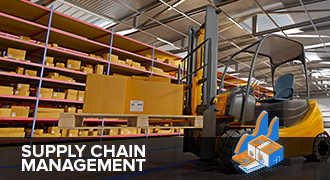Production Planning: A Strategic Reference Guide
The global economy dedicates vast amounts of time, capital, and mental energy to production planning. Some of our best minds spend their lives crunching data and trying to create the perfect product. Why? Well, follow the money.
Ready to transform your supply chain?

But make no mistake: a perfect product might only perform adequately if it lacks an excellent production plan.

So today we’re covering the basics on production planning. My goal is to cover the highlights here. After all, it’s always wise to get a refresher now and then. If we don’t, how else can remind ourselves of all the things we know? (That said, we often pick up a nugget or or two along the way that we hadn’t thought of before).
So let’s perform that triple lindy as we head back to school!
The Economic Key(ne)s: Goods, Labor, Finance, and Dance Moves?
In Business 101, you probably learned that John Maynard Keynes was one of the fathers of economics. His 1936 book, The General Theory of Employment, Interest, and Money, introduced the world to macroeconomics. And you probably learned how Keynes defined the broader economic landscape as what the International Monetary Fund (IMF) describes as three interrelated types of markets—
- Goods: These are transferable products or items that satisfy consumers’ wants and needs.
- Labor: This can apply to a single worker or the entire workforce. It refers to the individuals or groups performing the service of work.
- Finance: This means the analysis and distribution of resources while accounting for future risks (or costs) and rewards (or opportunities).
Prior to Keynes’s work, economics was essentially concerned with one big unruly economy. After Keynes? We had microeconomics and macroeconomics.
Nearly 100 years later, amid the complexity of globalization and modern business, it feels as if we’ve returned, in a way. Markets seems to have once more removed the dividing lines between Keynes’s goods, labor, and finance. Businesses plan the goods, make the goods, deliver the goods, and repeat. In other words, the modern company must operate with one foot in all three markets.
If that sounds like a difficult bit of footwork, all I can say is, Put on your dancing shoes! Choreograph a killer routine, and deliver a delightful performance.
Based on that blanket observation, we can summarize that agility, planning, and execution are three core tenets of 21st century business.
What Drives Production Planning?
Production planning is the allocation of resources (raw materials, labor, overhead) in order to supply (create and deliver) the goods (as fast as possible for the most profit) according to market pricing and customer demand.
The history of production planning dates back at least to the invention and adoption of railroads. In other words, production planning as a practice was one cog of the Industrial Revolution. In essence, as demand and supply increased, individuals and businesses needed greater degrees of production planning. Before long, production planning was operating similarly to the way we know it today.
Ultimately, the driver and motivation behind the practice of production planning is clear. To use an old saying, we’re getting our ducks in a row. We’re outlining and optimizing the organization and use of our business resources for peak efficiency and maximum return on investment (ROI).
The Four Basic Steps of Production Planning
ERPnext.com, a common software system used for planning, describes four key steps to successful production planning.
- Planning: This involves identifying the ideal allocation of labor and machines, as well as your cost and source of raw material listed on the bill of material (BOM). In other words, you’re creating the game plan.
- Routing: In this step, you map the actual route the product will take inside the factory from start to finish, in order to reduce waste.
- Scheduling: This stage in the process further hones the time allocation of personnel and machinery for performing the production task. In short, you’re assigning jobs.
- Loading: At this stage, you load up the assembly line, personnel, and machinery to identify any additional efficiencies. In other words, you’re conducting trial runs.
The goal in this preliminary phase of production planning is to look for pitfalls. A common pitfall that will grind production to a halt is lack of raw materials. In addition, bottlenecks at a slow machine or process can squeeze your workflow. Lastly, untrained personnel can lead to quality issues, bottlenecks, or slower throughput of product.
When you’ve accounted for these pitfalls, that can reduce waste. Another way of describing this type of successful streamlining is “learning cost out.” When you can learn some cost out of your processes, you put those dollars back in your pocket.
The Many Types of Demand Planning
While they all share similar goals, it’s worth noting that many flavors and acronyms of production planning exist. Below, I’ll list some of the highlights with links for further review:
- Advanced planning and scheduling (APS).
- Batch planning.
- Flow planning.
- Process planning.
- Mass production planning.
- Manufacturing resource planning (MRP).
One Best Practice to Rule Them All, or, What Are We Doing With All This Paperwork?
According to the International Monetary Fund, along with microeconomics and macroeconomics, there’s a third economic category: econometrics. Econometrics is essentially another way of saying quantifiable data. But the IMF says it’s also much more than that:
As Stock and Watson (2007) put it, “econometric methods are used in many branches of economics, including finance, labor economics, macroeconomics, microeconomics, and economic policy.” Economic policy decisions are rarely made without econometric analysis to assess their impact.
I think we’re all starting to realize the importance of data. For example, data’s a hot topic if you use social media. You might say data is so important because of how we can use it for planning purposes. Take enterprise resource planning (ERP), which we noted above. Your ERP system is only as good as the data you plug into it.
So having good, robust data is vital when you’re doing production planning. Indeed, there’s a correlation between the quality of your data and the quality of your production planning effort.
So, How Can You Get Better Data?
Digitized documentation is growing in popularity. And one major reason is that digitized documents mean accessible data. And as we just noted above, better data leads to better production planning.
What’s digitized documentation? It’s more than just scanning a piece of paper into the system. It’s also more than just a webpage. Instead, one way to think about digitized documentation is that it’s the best of both worlds. Imagine a paper scan that integrates with your back office transportation management system. Further, you can store all that data from digitized documents and access it in the cloud.
One of the leaders providing digitized document technology is a Silicon Valley tech company named Vector. Many trucking companies and warehousers in the logistics industry are adopting Vector’s app and software, but the application for their tech could also be useful for the greater manufacturing industry. The reason for that is data quality.
In reality, any business that still relies on paper documents and the manual processes that support paper is accumulating a weak source of data. Put another way, the manual process becomes the job. But that’s a trap. Because as you know, pushing a piece of paper from point A to B isn’t the job. It’s something like a byproduct of the actual job. Paper is an antiquated system.
Final Thoughts: Upgrade Your Back Office
All companies perform production planning. Any modern company dancing with one foot in Keynes’s three markets (goods, labor, and finance) needs better data.
The logistics industry is fully versed in both lean and agile manufacturing on the production and warehouse floor. Why not adopt those same methods of production planning to your back office? Think about how much time and how many resources you could save doing the important thought processes of production planning, with less paper to push.
Also, don’t forget that building a great game plan is only one part of success! Once the game starts, you can’t drop the ball. When production is up and running, it’s important to monitor your processes. Production control is the methodology of identifying and improving on inefficiencies and quality issues. Good data sources should help locate your inefficiencies, not be inefficiencies themselves.
In summary, put on your dancing shoes and deliver the goods! Class dismissed!
This post was written by Brian Deines. Brian believes that every day is a referendum on a brand’s relevance, and he’s excited to bring that kind of thinking to the world of modern manufacturing and logistics. He deploys a full-stack of business development, sales, and marketing tools built through years of work in the logistics, packaging, and tier-1 part supply industries serving a customer base comprised of Fortune 1000 OEMs.
Continue reading
Ready to transform your supply chain?
Increase efficiency and productivity. Say goodbye to delays, handwriting errors, and time-intensive manual data entry.



